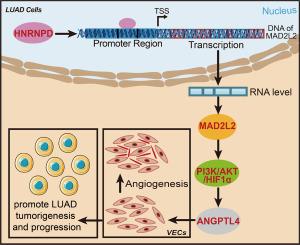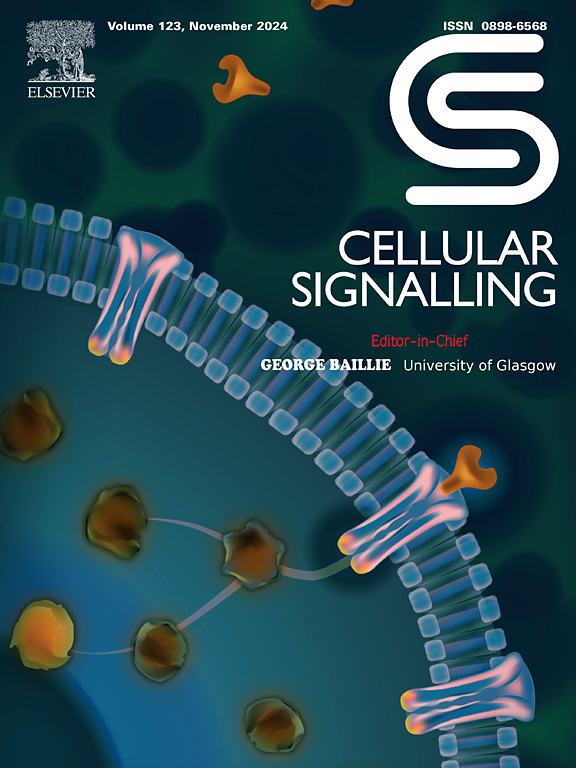HNRNPD/MAD2L2 axis facilitates lung adenocarcinoma progression and is a potential prognostic biomarker
IF 4.4
2区 生物学
Q2 CELL BIOLOGY
引用次数: 0
Abstract
Background
Although progress has been made in the treatment of LAUD, the survival rate for patients remains poor. An in-depth grasp of the molecular pathways implicated in LUAD progression is vital for improving diagnosis and treatment strategies. This study aims to explore novel molecular mechanisms driving LUAD progression and identify new potential prognostic biomarkers for LAUD patients.
Methods
Based on mass spectrometry analysis of human LUAD tissues, HNRNPD and MAD2L2 were identified as potential key proteins involved in LUAD progression. Subsequently, the interplay between HNRNPD and MAD2L2 was examined through dual-luciferase reporter assays, RNA-seq analysis, and various molecular biology techniques. Ultimately, the role of the HNRNPD/MAD2L2 axis in LUAD advancement and its potential as a prognostic indicator were investigated utilizing LUAD specimens, cell lines, and xenograft mouse models.
Results
In human LAUD tissues and cell lines, elevated levels of HNRNPD and MAD2L2 proteins were discovered. It was determined that HNRNPD binds to the MAD2L2 promoter, forming a regulatory axis at the transcriptional level. Subsequently, both in vitro and in vivo data demonstrated that the downregulation of the HNRNPD/MAD2L2 axis inhibited LUAD progression, while this effect could be rescued by MAD2L2 upregulation. Conversely, the upregulation of the HNRNPD/MAD2L2 axis facilitated LUAD progression, and this outcome could be reversed by MAD2L2 knockdown. Mechanistically, the downregulation of HNRNPD suppressed the promoter activity and transcription of MAD2L2, thus inhibiting the PI3K/HIF1α/ANGPTL4 pathway and tumor angiogenesis. Finally, it was confirmed that LUAD patients with high levels of both HNRNPD and MAD2L2 exhibited the poorest prognosis. Therefore, the HNRNPD/MAD2L2 axis has been identified as a potential predictive indicator for LUAD patients.
Conclusions
The HNRNPD/MAD2L2 axis facilitates LUAD progression and serves as a potential prognostic biomarker.

HNRNPD/MAD2L2轴有助于肺腺癌的进展,是一种潜在的预后生物标志物。
背景:尽管LAUD的治疗取得了进展,但患者的生存率仍然很低。深入了解LUAD进展的分子通路对于改善诊断和治疗策略至关重要。本研究旨在探索驱动LUAD进展的新型分子机制,并为LAUD患者确定新的潜在预后生物标志物:方法:基于对人类 LUAD 组织的质谱分析,HNRNPD 和 MAD2L2 被确定为参与 LUAD 进展的潜在关键蛋白。随后,通过双荧光素酶报告实验、RNA-seq分析和各种分子生物学技术研究了HNRNPD和MAD2L2之间的相互作用。最后,利用LUAD标本、细胞系和异种移植小鼠模型研究了HNRNPD/MAD2L2轴在LUAD进展中的作用及其作为预后指标的潜力:结果:在人类 LAUD 组织和细胞系中,发现 HNRNPD 和 MAD2L2 蛋白水平升高。结果:在人类 LAUD 组织和细胞系中发现 HNRNPD 和 MAD2L2 蛋白水平升高,并确定 HNRNPD 与 MAD2L2 启动子结合,在转录水平形成调控轴。随后,体外和体内数据都表明,下调 HNRNPD/MAD2L2 轴可抑制 LUAD 的进展,而上调 MAD2L2 则可挽救这种效应。相反,HNRNPD/MAD2L2 轴的上调促进了 LUAD 的进展,而这种结果可以通过敲除 MAD2L2 而逆转。从机制上讲,HNRNPD的下调抑制了MAD2L2的启动子活性和转录,从而抑制了PI3K/HIF1α/AGPTL4通路和肿瘤血管生成。最后,研究证实,HNRNPD和MAD2L2水平均较高的LUAD患者预后最差。因此,HNRNPD/MAD2L2轴被认为是LUAD患者的潜在预测指标:结论:HNRNPD/MAD2L2 轴促进了 LUAD 的进展,是一种潜在的预后生物标志物。
本文章由计算机程序翻译,如有差异,请以英文原文为准。
求助全文
约1分钟内获得全文
求助全文
来源期刊

Cellular signalling
生物-细胞生物学
CiteScore
8.40
自引率
0.00%
发文量
250
审稿时长
27 days
期刊介绍:
Cellular Signalling publishes original research describing fundamental and clinical findings on the mechanisms, actions and structural components of cellular signalling systems in vitro and in vivo.
Cellular Signalling aims at full length research papers defining signalling systems ranging from microorganisms to cells, tissues and higher organisms.
 求助内容:
求助内容: 应助结果提醒方式:
应助结果提醒方式:


